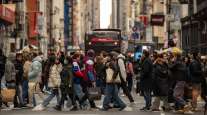Staff Reporter
Trucking Adapts to Spike in Consumer Demand

[Stay on top of transportation news: Get TTNews in your inbox.]
Trucking is handling increased demand and awaits a potential surge of pent-up activity because of the coronavirus, but what that means for the industry long term remains an open question.
For now, the virus has spurred consumers into stocking up on food and other essentials, and trucking has been vital in ensuring that those necessities reach store shelves.
“I’m so impressed and proud of how truck drivers and the industry stepped up and are replenishing stores from unprecedented surge demand,” American Trucking Associations Chief Economist Bob Costello told Transport Topics. “With that said, the surge in freight from coronavirus will come to an end, and it will be soft on the other side.”

Costello
He noted that an additional consideration is factories, such as in the automotive sector, are closing temporarily, restaurants are shutting down and workers are being laid off. Costello said that is not a good combination for freight volumes.
“The freight industry for much of the past year has been struggling with not enough demand. We know since roughly late 2018 the freight industry has been in a contraction,” Aaron Terrazas, economist at digital freight-matching company Convoy, told TT. “So the surge in demand is something that is giving more business to a lot of carriers that desperately needed it.”
The industry had an exceptionally good year with high rates and volumes in 2018 and a downturn in 2019. But now, the coronavirus is dashing hopes of a rebound for at least the first half of this year.
“That said, it’s not evenly spread across the country and across all sectors,” Terrazas said. “We do have a lot of demand for those carriers going into the big urban centers that got hit first, but there still is very little demand coming out of those adversely affected areas like the big China trade ports.”
There are 413,467 confirmed cases of COVID-19 worldwide as of March 25, according to figures posted on the Centers for Disease Control and Prevention’s website, and 54,453 confirmed cases in the United States.
“The U.S. trucking industry faces a very difficult period in the coming months as freight volumes will drop materially in the managed temporary shutdown of the economy resulting from COVID-19,” Timothy Denoyer, vice president and senior analyst at ACT Research, told TT. “In the past few weeks, strong demand to restock at the retail level has helped trucking conditions, but that is about to change on a sharp decline in manufacturing and retail activity in Q2.”

Denoyer
Denoyer expects second-quarter truckload volumes to fall almost 20% on a year-to-year basis. This will hurt rates in the near term, further impacting the industry. But he also expects economic stabilization in the third quarter and recovery in the fourth quarter.
“Three of the four major Class 8 truck [original equipment manufacturers] have either sharply or entirely curtailed truck production, and the restart timing is very tough to know,” Denoyer said. “If this downtime goes on too long, it could cause a capacity crunch. It depends on the depth and length of the downturn, but this is just accelerating a cyclical change that’s already been underway.”
He added that if there is a freight-activity rebound but tightening Class 8 capacity, truckload spot rates could rise 30% to 40%.
“Prior to COVID-19, the trucking industry was already transitioning from overcapacity in 2019 back toward balance,” Denoyer said. “But now we have a scenario where Class 8 commercial vehicle production is one of the industries severely impacted by this managed shutdown of the economy.”

Perry
Transport Futures economist Noel Perry sees three general scenarios that could result from the crisis. The best case and least likely outcome is a turnaround along with a stimulus package could leave things slightly better off. The most likely outcome is the economy equals out after the outbreak. The worst case is the economy becomes severely damaged long term.
“The best case scenario is the second half of the year, we could end up slightly better than we started and have a good first half of 2021,” Perry told TT. “Everything else in the middle is if we’re lucky, we’ll make up for what we lost.”
Perry thinks the pent-up demand could cause a surge later this year but that will only really make up for the losses. He said the stimulus potentially could help more, but he finds that to be unlikely.
“We could get a down and then an up,” Perry said. “The up will feel good, but it won’t do more than offset the down. People will look back and say, ‘What a flat year.’ People will declare victory in the fall because we’re growing again. But will we get back to where we were when it started? I don’t think so.”
Want more news? Listen to today's daily briefing:




